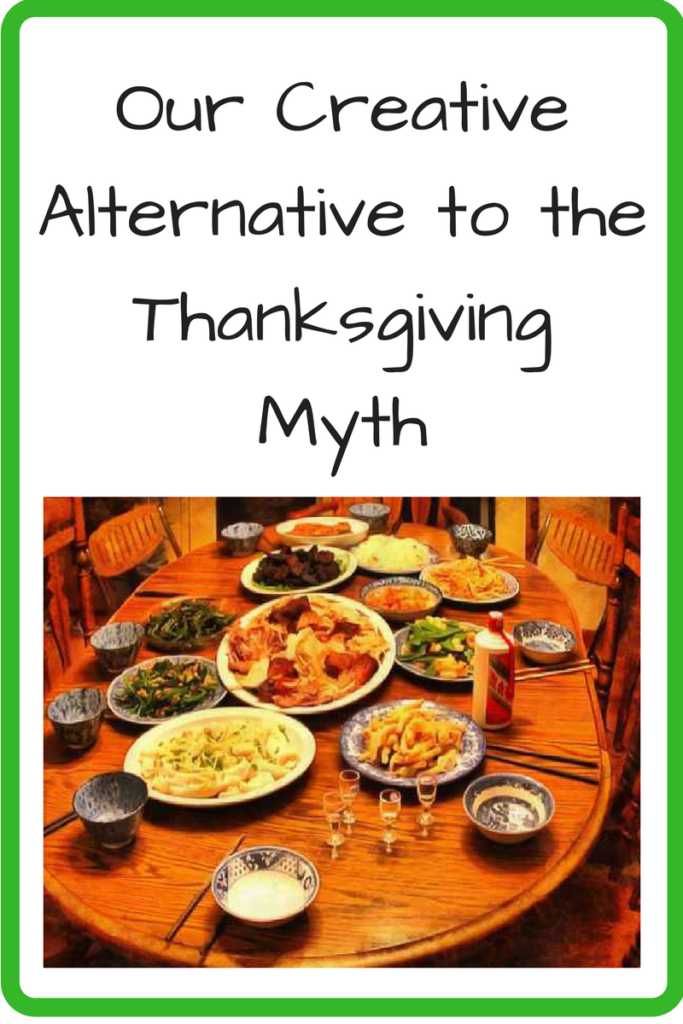
“They’re not dressing up as Native Americans, are they?” I said, wrinkling my nose. After reading about how cultures aren’t costumes around Halloween and how the whitewashed version of the Thanksgiving story is painfully inaccurate, I hope that my son’s preschool isn’t re-enacting the famous version of the Thanksgiving narrative. Regardless of their curriculum, I know we won’t be repeating it in our household. So we have to come up with an alternative.
Not Quite Picture Book Material
But what can we tell a preschooler about Thanksgiving if not the “pilgrims and Indians” story? The real version is complex – it involved the Puritans stealing corn from Native American graves (nice job, folks) and the Native Americans rightfully sending spies to ensure the Puritans weren’t going to slaughter them. The actual Thanksgiving feast was likely an extended business / military meeting where both sides wondered if the other was going to murder them the entire time. Not to mention the fact that the reason Plymouth was relatively empty was that diseases brought from Europe wiped out 9 / 10 of the Native American population years before. Or the fact that the Puritans weren’t very shy about murdering Native Americans in the years after the feast.
This is not picture book preschool-friendly material. In fact, most of the tellings of the Thanksgiving story that Native American activists recommend are for fourth grade and above.
Sharing Our Stories of Gratitude in America
Instead, we’re going to tell our own stories of Thanksgiving. The Canadians celebrate Thanksgiving with no mention of self-righteous Pilgrims, so we can do that too. In fact, cultures have been celebrating harvest festivals of thanks for millennia.
Instead of the Mayflower, our stories of Thanksgiving will focus on much more recent journeys – the immigration of our own ancestors to America. My great-grandfather and grandmother on opposite sides of the family have fascinating, adventurous immigration stories.
My great-grandfather came over from Czechoslovakia when he was only 13, with few possessions or English words in his vocabulary. He set off on his own at only 15. Then at 18 years old, he (unsuccessfully) attempted to bike around the world with his friends.
My grandmother was born in Poland, as her mother had returned to visit family and get money after immigrating to America. My great-grandmother didn’t realize she was pregnant until it was too late. The American authorities wouldn’t let them enter the country until my grandmother was at least three. As a result, she didn’t meet her father until they stepped off the boat. Her first memories were of seeing the Statue of Liberty and meeting him for the first time.
Unlike the sanitized story of the Pilgrims, these are authentic stories about wanting a better life in America. They’re full of bravery and overcoming hardship. Research has shown that kids benefit greatly when we tell them family stories, especially those that have a positive ending after struggle. I know hearing these stories – often during the holidays – instilled many of the values I hold dear today. They inspire gratitude that we have privileges now because of the risks our relatives took way back then.
Teaching Radical Welcome
I also hope to talk about all of the immigrants we’re glad to have in our lives now. My children’s lives are filled with people from different countries, from kids at church to classmates’ parents to our neighbors. We’ll talk about how we’re glad they’ve been able to find opportunities in America. I hope by talking about our family’s history of immigration and that of the people we love, we can instill the value of “radical welcome” in our kids.
Like everything in history, Thanksgiving is a complex, multi-faceted event. But if I can, I’d like to replace Plymouth Rock as the symbol of Thanksgiving with the Statue of Liberty. America isn’t a shining beacon of welcome – especially now – but that doesn’t mean we shouldn’t strive for that ideal.
To me, that’s what Thanksgiving is all about – giving thanks and making our country a place where even more people can be thankful. If I can teach that lesson to my kids, it will be better than a thousand construction paper Pilgrim hats.
For more on my family’s stories, check out Sharing Values with Family Stories. Be sure to follow us on Facebook!
I lovr this Shannon!! I really like the welcome perspective too and shedding light about immigrants to our kids! Happy Turkey weekend!
Thank you! I hope you have a great Thanksgiving!
This is a great idea! Not having kids in school, we have mostly skipped the pilgrim story but haven’t found anything with which to replace it. We mostly have just talked about what we’re thankful for, but I’m going to start thinking of family stories to share. Thanks!